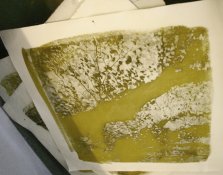As some of you know, I constantly make bromoil prints using liquid emulsion as matrix.
There's something strange going on (some times) in the bleach process, that I don't understand..
Normally I get a bleach, where all the silver (blacks) are removed by the bleach. As it should. After rinsing/fix and rinsing, almost no image can be detected.
However, sometimes it looks like only the deep blacks are removed - the image doesn't look bleached and it doesn't matter how long I leave the image in the bleach...
Images made with the exact same chemicals as the ones that dissapear all together...
Anyone can explain this? The image can normally still be inked, but it is hard work, and it looks different.
Also, there's a brown residue left in the bleach after bleaching.. what is that, and is that a good thing or not...
Inquiring minds want to know...
attached two images as they look right after the bleach (but before the final fix, where the warm tone dissapear)...
There's something strange going on (some times) in the bleach process, that I don't understand..
Normally I get a bleach, where all the silver (blacks) are removed by the bleach. As it should. After rinsing/fix and rinsing, almost no image can be detected.
However, sometimes it looks like only the deep blacks are removed - the image doesn't look bleached and it doesn't matter how long I leave the image in the bleach...
Images made with the exact same chemicals as the ones that dissapear all together...
Anyone can explain this? The image can normally still be inked, but it is hard work, and it looks different.
Also, there's a brown residue left in the bleach after bleaching.. what is that, and is that a good thing or not...
Inquiring minds want to know...
attached two images as they look right after the bleach (but before the final fix, where the warm tone dissapear)...







